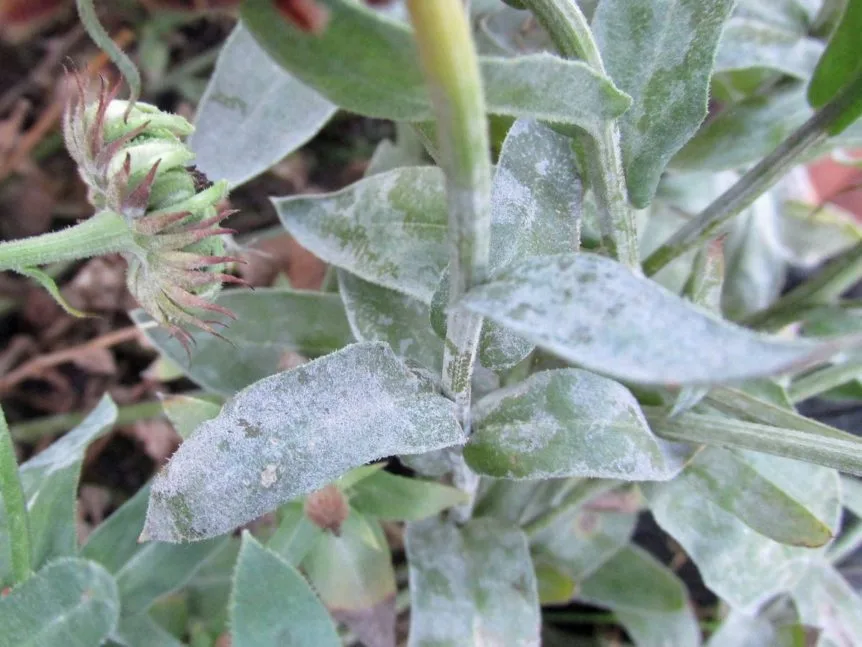Thanks to Chuck Burges and Joey Williamson, Ph.D., HGIC Horticulture Extension Agent at Clemson University, for all the great information referenced in this blog post!
Introduction
Powdery mildew is the name given to a group of diseases caused by several closely related fungi. Their common symptom is a grayish-white, powdery mat visible on the surface of leaves, stems, and flower petals. There are many hosts, and although this disease is not considered fatal, plant damage can occur when the infection is severe.
Disease Cycle
In spring, as daytime temperatures rise above 60 °F, the powdery mildew produces spores, which disperse into the air. When the spores contact a suitable host and environmental conditions are favorable, infections are likely to occur. Initial symptoms are small, circular, powdery, white spots, which expand and eventually join as infections progress. Infections spread as spores produced in these white patches move by wind and splashing rain to other locations on the plant or nearby plants.
The fungus survives the winter attached to plant parts and plant debris, such as on fallen leaves. Then, as the weather warms in the spring, the process begins again.
Favorable Conditions
Humidity is an essential factor for the onset and spread of powdery mildew. High relative humidity favors spore formation. Low relative humidity favors spore dispersal, which explains why powdery mildew tends to be a problem when the days are cool and the nights are humid. Temperature is also a factor. Although powdery mildew can occur all season long, it is less common during the summer heat.
Hosts
Ornamental plants that commonly become infected with various powdery mildew include azalea, dogwood, phlox, euonymus, dahlia, zinnia, crape myrtle, rose, rhododendron, spirea, wisteria, delphinium, and English ivy.
Symptoms
As powdery mildew fungi grow over the plant surface, they extract nutrients necessary for growth, resulting in a general decline in the host’s development, vigor, and aesthetics.
Abnormal growth, such as leaf curling, twisting, and discoloration, may be noticed before the white signs of the fungus are visible.
When visible, the powdery fungal growth is found on the upper surface of the leaves and tends to begin on lower leaves. As the disease progresses, leaves become dwarfed, curled, and generally distorted. In severe cases, leaves will turn yellow or even dried and brown.
Powdery mildew fungi will also infect flowers, causing them to develop abnormally or fail to open.
Cultural Controls
As with all diseases, optimum plant health is the first line of defense. Plant health begins with selecting healthy plants, planting them correctly and in the proper location, and giving attention to light, soil, and moisture requirements. Space them so they can grow without being crowded and water thoroughly during establishment and later during dry periods. Avoid overhead irrigation, which raises the level of relative humidity within the plant canopy.
If powdery mildew is noticed on a few leaves, simply removing them will help with control. Prune out infected stems and remove fallen leaves, which can serve as a source of further infection. Suckers are common on crape myrtle, dogwood, and other plants and should be pruned off as they develop because they are especially susceptible, and the disease will spread from them upwards to other plant parts.
Fertilize to optimize plant health, but avoid over-fertilization with nitrogen as it stimulates young, succulent growth, which is more susceptible to infection.
Plants with a severe infection should be monitored the following spring so that if infections reoccur, they can be treated early.
Chemical Control
For fungicides to be effective, they must be applied as soon as symptoms are noticed. Apply fungicides more frequently during cool, damp weather. Be sure to cover both the upper and lower surfaces of the leaves.
Fungicides such as Myclobutanil, propiconazole, and thiophanate-methyl have systemic properties and can be sprayed less often than chlorothalonil, sulfur, or copper-based fungicides. However, when powdery mildew persists and sprays are repeated, it is recommended to rotate (alternate) fungicides to decrease the chance of fungi developing resistance.



Comments (0)
Thanks for your comment!
Thanks for your feedback! Your comments have been successfully submitted! Please note, all comments require admin approval prior to display.
Error submitting comment!
There is a problem with your comment, please see below and try again.